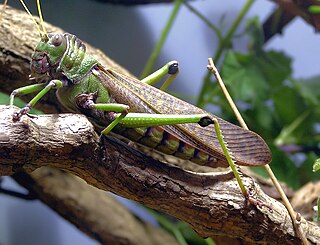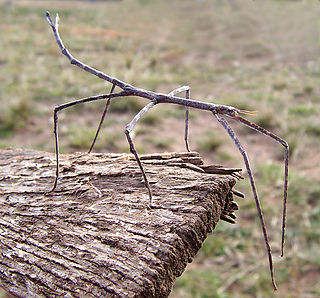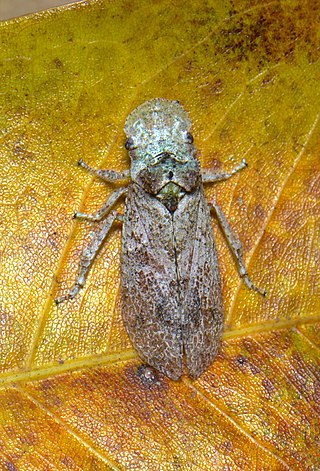
Blattidae is a cockroach family in the order Blattodea containing several of the most common household cockroaches. Some notable species include:

Eremiaphilidae is a small Old World family of praying mantids, based on the type genus Eremiaphila. As part of a major revision of mantid taxonomy, this family now contains the subfamily Tarachodinae, which includes tribes and genera previously placed in the now obsolete Tarachodidae.

The family Fulgoridae is a large group of hemipteran insects, especially abundant and diverse in the tropics, containing over 125 genera worldwide. They are mostly of moderate to large size, many with a superficial resemblance to Lepidoptera due to their brilliant and varied coloration. Various genera and species are sometimes referred to as lanternflies or lanthorn flies, though they do not emit light.

Eurybrachidae is a small family of planthoppers with species occurring in parts of Asia, Australia and Africa. They are remarkable for the sophistication of their automimicry.

The Romaleidae or lubber grasshoppers are a family of grasshoppers, based on the type genus Romalea. The species in this family can be found in the Americas.

The Phasmatinae are a subfamily of stick insects in the family Phasmatidae. They contain at least three tribes; Bradley and Galil corrected the spelling to "Phasmatinae" and provides a key to tribes.

The subfamily Aphaeninae is a group of hemipteran insects, especially abundant and diverse in the tropics. They belong to the Fulgoridae (fulgorids), though they are not among the better-known members of that family that are called "lantern bugs" or "lanternflies". In 2009, the first molecular analysis of the Fulgoridae challenged the existing structure of eight currently recognized subfamilies and eleven tribes.

Flatidae are a family of fulgoroid planthoppers. They are cosmopolitan in distribution and are distinguished from others in the superfamily by a combination of characters. Like all other planthoppers, they suck phloem sap of plants. Some species are known to communicate with vibrations through the plant stems. Communication may be with mates, or with ants that tend the nymphs, protecting them and gathering honeydew secretions. Adults of some species have brightly coloured forewings which are tougher and known as tegmina unlike the membranous hindwings which are used for flight. Although a few can be identified by their coloration, most species requires dissection and examination under a microscope with access to literature on already described species.

Issidae is a family of planthoppers described by Spinola in 1839, belonging to the order Hemiptera, suborder Auchenorrhyncha superfamily Fulgoroidea.

Cixiinae is a planthopper subfamily in the family Cixiidae. It is one of three such subfamilies, the other two being the Bothriocerinae and the Borystheninae. While a few species had been tested in a larger study of the Fulgoroidea, neither the Cixiinae nor its tribes were analysed cladistically until 2002. Resolution of tribal relationships is incomplete and additional testing of the tribes with samples larger than one per tribe is needed.

Ledrinae is a relatively small subfamily within the very large and diverse leafhopper family Cicadellidae. Originally placed in its own family, the "Ledridae", it is based on the type genus Ledra.

Smiliinae is a subfamily of treehoppers in the family Membracidae. These are bugs and include about 100 genera in 10 tribes.

Achilidae is a family of planthoppers, sometimes called "achilids" in the order Hemiptera. There are at least 520 described species in Achilidae.
Myconus is a genus of achilid planthoppers in the family Achilidae and the type genus of the subfamily Myconinae and tribe Myconini; species have been recorded from South America and East Africa.

Derbinae is a subfamily of derbid planthoppers in the family Derbidae.

Dictyopharinae is a subfamily of dictyopharid planthoppers in the family Dictyopharidae. There more than 100 genera and 500 described species in Dictyopharinae.

Membracinae is a subfamily of treehoppers in the family Membracidae. There are more than 40 genera in Membracinae.

The subfamily Poiocerinae include Hemipteran insects in the family Fulgoridae, found especially in the tropics.

The Flatinae are a subfamily of planthoppers, erected by Maximilian Spinola in 1839. Genera have been recorded from all continents except Antarctica: especially in tropical and subtropical regions.

The Mictini are a tribe of leaf-footed bugs, in the subfamily Coreinae erected by Amyot & Serville in 1843. Genera are distributed from Africa to South-East Asia.



















